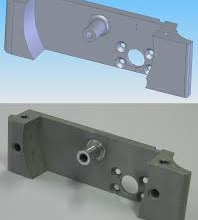
Training monitoring is an effective way to quantify your performance and help you improve your time. A sports watch will be of great help. We tell you what to look for when choosing a high-level one.
Whether you have decided that the time has come to get in shape or if you already exercise regularly, a sports watch will help you to measure your progress.
And is that if you record your performance day by day, with the passing of the months you will have data to be able to evaluate your evolution and know if you are progressing properly to achieve your goals.
While smartbands allow you to register your workouts, their functions may fall short if you take sports very seriously. For this reason, if you already have a certain level or would like to reach it, your sports watch should also offer you the highest level. We give you some keys in which you should look to choose the sports watch that best suits you.
First of all, comfort
Taking into account that the smartwatch you will use while exercising, comfort is one of the main features that you have to take into account when choosing yours.
In the same way that you need shoes that adapt perfectly to your footprint or the shape of your foot, your sports watch should be especially comfortable.
A sports watch that is too heavy will be an additional burden on your wrist that could even condition your movements when running, swimming or performing the precise movements that your sports activity requires.
In the same way, a sports watch that is too bulky can also be an obstacle to your training performance. The latest fashion trends point to watches with bulky spheres. These solutions are perhaps suitable for sporadic or undemanding sports use, but when each movement counts for maximum performance, every gram of more in a ballast.
Therefore, as with the rest of your sports equipment, keep in mind the maximum “less is more” to choose the device that offers the best balance between weight, size and performance.
A suitable watch for each type of sport
You do not use a sanitary thermometer to measure the ambient temperature, nor the bicycle inflation pump to inflate the wheels of your car. Why would you use a sports watch that is not able to efficiently monitor the values that really matter in your sports activity?
It is of little use that your watch is able to monitor 50 different sports activities if it is not able to correctly record the one you practice.
There are different sports watches specialized in a certain activity, although later it can be derived in different disciplines. The clearest example we have in the models specialized in athletics, which then allow you to choose between different disciplines to activate more focused values in it.
That way, if you choose the 5,000 meter mode, it will show you the number of laps, while if you choose a marathon, it will skip that data to show you other values such as heart rate or distance.
In this sense, it is also important to take into account the materials that make up the sports watch. It doesn’t make much sense to choose a metal watch when swimming or other water or water sports. In that case, it is best to opt for boxes made of stainless steel or polycarbonate and silicone straps, instead of choosing watches made of different metal alloys.
Whatever sport you practice, we recommend that the sports watch is always waterproof with a minimum certification of 5 ATM that guarantees its tightness.
This feature is not always related to water sports as it also guarantees total resistance to sweat, splashes that you will receive when you cool down and even in heavy rain.
A screen adapted to the type of sport
During the training you will not have more than a second to read the information on the screen of your watch, so it is important that it be clear and only show the necessary information in each case, regardless of whether it is collecting another background type of information.
Therefore, it is necessary that the sports watch has a bright screen. That way, you can clearly read the information on the screen even when you are training in full sun.
Another important detail related to the screen is that it allows to display the information in different colors. If you can only take a quick look at the information on your watch during training or during the competition, differentiating it by colors is a way of focusing visual attention on a certain value bypassing the rest, so the reading is faster.
The most current sports watches are equipped with AMOLED screens that offer low battery consumption and allow you to customize the information shown on the screen and the spheres so that the data that you really find useful during the sport activity is displayed.
Integrated monitoring functions
Depending on the amount of information you want to obtain from each training, you will be interested in the clock integrating more or less sensors, so that each one is responsible for monitoring a specific parameter.
When choosing your high-level sports watch you will discover that the most common are the functions that control parameters such as speed, number of steps or stride cadence, but can also measure many other parameters.
As you can imagine, the more values it is able to measure, the higher its price will be since it must integrate a greater number of sensors. Therefore, it is possible that, rather than having many functions, having the ones you really need for your sports activity to avoid extra costs with functions that you really do not need.
Some of the leading brands of sports watches such as Garmin, Fitbit, Polar or Suunto offer sports watches specialized in specific sports activities, so that their sensors specialize in measuring certain important values in that activity.
The result is much more precise measurements than those obtained in generic smart watches or in multi-sport sports watches.
Connectivity with other devices
One of the features that you should demand from your sports smartwatch is good connectivity.
We are not talking about being able to watch videos on the watch screen – here we have come to train – but one of the main reasons why you should wear a sports watch is precisely to collect the data of your training and send it to your smartphone to Create a historical profile of your evolution with the data collected during training.
The Bluetooth is the most common way to connect with your smartphone sports watch system and other intelligent devices that can help you get better performance.
Currently sports equipment has evolved in an incredible way. For example, in road cycling, sensors are used on the pedals that collect data on the cadence, pressure and pedaling efficiency. All this information can be synchronized with the sports watch, which will act as a storage HUB for all training data.
Something more traditional is the connection of sports watches with heart rate monitors , much more efficient than the systems that perform measurements on the wrist since the reading closer to the heart is collected.
It is difficult to calculate the market cost of a smart watch with GPS, submersible, with synchronization of notifications and also offers a battery of one month. What we do know is that you can get it for less than 80 dollars.
Sports watches do not have to have an exclusive use in training, so you may also be interested in incorporating other smart connectivity features with your smartphone for day to day.
Some of the most interesting functions may be the functions that allow you to receive notifications from your smartphone on your sports watch, such as when you receive an email, a WhatsApp message or a call. Some even allow you to answer those messages from the clock.
A feature of sports watches that is usually very well received by athletes is the ability to control the music that is being played on a synchronized device, and even from the watch itself.
This allows more efficient control of the music that accompanies many athletes during their workouts, without having to stop to manipulate the smartphone or mp3 player.
A battery capable of holding your rhythm
As with any electronic device, having a good battery life is an essential part of obtaining a good user experience.
Obviously the battery life is directly related to connectivity and monitoring functions, the more sensors and wireless systems are in operation, the lower the autonomy.
At this point, the big difference is the GPS connection. This function provides important information about the characteristics of your workouts since, as we mentioned in the previous section, it allows you to record the routes of your training.
However, using this function can dramatically cut the autonomy of the watch, going from a use of several days to only a few hours.
When choosing a high-level sports watch for exercise it is important to know the estimate of the battery life of the manufacturer. These data are merely indicative, but they will help you get an idea of the level of optimization of the consumption of the GPS connection.
Manufacturers estimate the battery usage time in ideal, non-real conditions, so you can imagine that when you carry it on your wrist, connected to your smartphone or with a certain configuration, your battery will last a little less.
Taking this into account will help you choose a sports watch that will not leave you lying in the middle of a workout for running out of battery.
Compatibility with your monitoring app
The main mission of sports watches is to show and collect data from each training session, which is why it is important that you have a good battery of sensors.
However, all that information will be of little use if then the clock is not compatible with the application you usually use to segment that data and present it in a way that helps you improve by showing you your strengths and weaknesses.
Most commonly, each manufacturer offers its own app in which the graphs of the collected data are displayed. Some of these apps can be really interesting, and present the data clearly. However, it is best to choose a sports watch that is compatible with third-party apps such as Google Fit, Apple Health, Strava, Endomondo or any of the multi- device sports apps that exist in the market.
The Samsung Galaxy Watch is the last smartwatch of the South Korean company. It has a very elegant design and similar to that of the previous generation, the Gear S3, but also sports functions to be a great watch for sports.
This ensures that, if one day you change your device, your training data will not be “trapped” in the app of a certain manufacturer, allowing you to create a training profile independent of the device you use.
Now you know what to look for when choosing a high-level sports watch for exercise, but you have an important challenge ahead: choose the one that meets all the requirements you need for your workouts.




